Anti-aircraft self-propelled installation M19 Multiple Gun Motor Carriage (USA)
Creating a promising ZSU with small-caliber cannon armament based on the existing light tank was launched in 1942 year. The troops needed a combat vehicle based on the M5 Stuart light tank with two Bofors 40-mm caliber guns in a full-swing armored turret. Such a machine could move in the same columns or combat formations with the existing armored vehicles of various types, carrying out their anti-aircraft defense. Preliminary studies have shown that the selected chassis and guns are able to solve the tasks. The project of the new ZSU received the designation T65 Multiple Gun Motor Carriage.
The first draft of the T65 project was developed by the end of 1942 of the year. Within the framework of this project, it was decided to use the existing solutions for the layout of self-propelled artillery systems, modifying them in accordance with the existing requirements. So, it was planned to rework the layout of the base tank chassis M5 with the transfer of the engine from the stern to the central part, to the place of the former combat compartment. Tower with crew jobs and weapons, in turn, should have been located in the aft of the hull.
According to some reports, the construction of the T1943 prototype self-propelled gun was launched in the spring of 65, but it was soon canceled. In April, the 43-th command decided to develop a new project, which received the code name Light Combat Team. As part of this program, it was planned to create a whole family of new armored vehicles for various purposes based on the tank of the existing model. At the same time, in order to achieve the highest possible performance, they offered to take the newest lightweight tank, the M42 Chaffee, as a basis for the family. In connection with such changes in plans, it was decided to rework several existing projects, including T65. A new version of this ZSU received the designation T65E1.
Despite the different purpose, the new technique based on the M24 tank had to use the chassis of a similar design. According to the experience of the development and operation of existing equipment based on medium and light tanks, it was decided to use a common layout for all such machines with the engine location in the central part of the hull and the aft fighting compartment. ZSU T65E1 MGMC is no exception to this rule.
During the development of the project Light Combat Team, a modified Chaffi tank chassis with the required layout was created. It retained some common features of the base machine, but received a number of noticeable differences. So, in front of the building there was a transmission compartment, behind which there was a two-seat control unit. For the driver and commander, the engine compartment was provided with engines, radiator, etc., and the feed was given under the fighting compartment with the necessary armament.
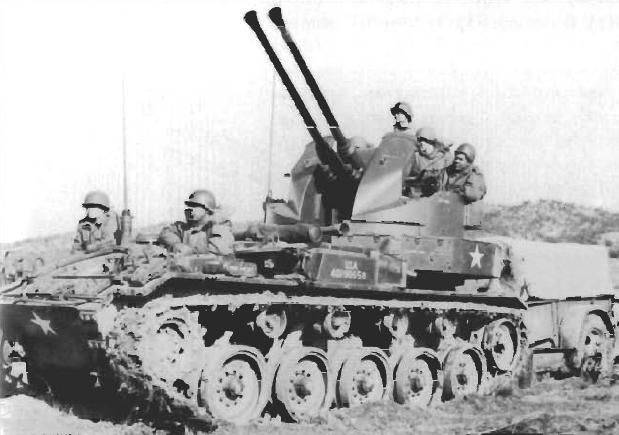
M19A1 on the front. Behind the self-propelled gun seen a trailer with ammunition. Photo of Wikimedia Commons
The case of such a chassis was a modified version of the M24 units, assembled from a large number of armor plates from 15 to 38 mm in thickness. In this case, the shape of the case has changed. Its frontal part consisted of three sheets located at different angles to the vertical. In place of the base tank turret there was a horizontal hull roof with ventilation grilles and service hatches. In the aft of the hull, in the case of the ZSU T65E1, a shoulder strap with a diameter of 2,16 m was provided for the installation of a tower of the original design.
In the middle compartment of the hull, two Cadillac 44T24 petrol engines with 110 horsepower each were located. With the help of a cardan shaft passing through the control compartment, the engine was connected to the transmission units. The latter set in motion the front drive wheels. The undercarriage of such a “universal chassis” was borrowed from the M24 tank without any changes. She had six double road wheels with a torsion bar on each side. Also provided for four supporting rollers on board.
On the aft hull of the ZSU hull T65E1, it was proposed to install a turret with crew positions and weapons. A U-shaped gun shield with vertical guidance mechanisms was mounted on the main cylindrical assembly of the tower. In addition, two niches were provided on the sides of the tower for the installation of various equipment, including a radio station. In the central part of the tower were mounted for two automatic guns. On the sides of them and in the stern of the tower places for the crew were established. On the outer surface of the tower was fixed a large number of boxes for the transport of ammunition. The tower was made of armor plates with a thickness from 6,3 to 13 mm.
T65E1 armed with two 40-mm automatic guns M2 firm Bofors. The guns were equipped with hydraulic and manual guidance mechanisms. The rotation of the entire tower provided a circular guidance horizontally. Vertical guidance mechanisms allowed firing with elevation angles from -3 ° to + 85 °. The maximum speed of horizontal guidance reached 40 ° per second, vertical - 25 ° per second. For aiming weapons used sights types M13, M23 and M24, located to the right and left of the gun unit.
The guns were supplied with ammunition using cassettes that were loaded into gun receivers. The technical rate of fire of the used guns reached 120 rounds per minute. During the development of the ZSU T65E1, such parameters were considered sufficient to effectively combat aerial targets. The total ammunition load carried in the drawers of the turret consisted of 352xXNNUMX mm R shells. In addition, additional ammunition should be transported in a special trailer.
Used guns could use high-explosive or armor-piercing shells, the initial velocity of which reached 880 m / s. The maximum firing range exceeded 7,1 km. At the same time, for effective destruction of targets, depending on their characteristics, it was necessary to reduce the firing range. Due to the use of an appropriate projectile, it was possible to attack not only air targets, but also land vehicles of various classes, as well as enemy enemy manpower.
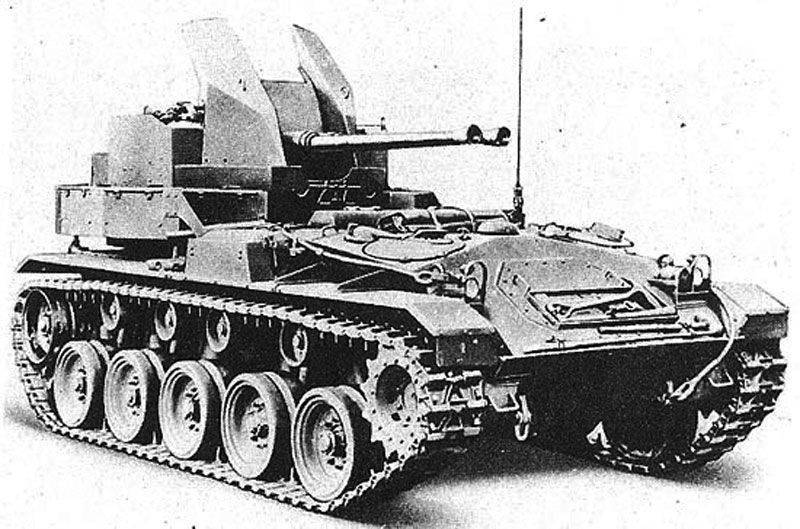
General view of the self-propelled gun. Photo Militaryfactory.com
The crew of the machine T65E1 was to consist of six people. The commander and the driver were located in front of the hull, in the control room. In the tower there were two gunners (on the sides of the guns) and two gunners who were responsible for loading the guns (at the stern wall).
For self-defense self-propelled gun could use machine gun M2HB, mounts for which were provided on the machine. The crew also had personal small arms, which could also be used to protect against enemy personnel.
Like the other equipment of its family, the T65E1 MGMC self-propelled self-propelled gun was almost the same size and weight as the Chaffee base tank. The length of the vehicle was 5,8 m, width 2,93 m, height (at the upper point of the gun shield) - 2,96 m. The combat weight was set at the level of 18 t. With the help of two petrol engines of 110 hp. the car could reach speeds of the order of 55 km / h and travel up to 160 km at a single fueling. The rise on the slope of the 60% or 100-cm wall, the intersection of a ditch with a width of 2,74 m and movement along a ford to a depth of 1,07 m were provided.
Together with the anti-aircraft self-propelled gun, it was proposed to use a special wheel trailer M28 for transporting additional ammunition. It was a standard uniaxial trailer, refined by mounting mounts for ammunition boxes. The trailer provided space for 20 boxes of the M14 type, each of which contained 16 shells for cannons - all 320 shots. If necessary, the trailer could be covered with an awning. The trailer was towed by means of a triangular frame with a loop connected to the towing device of the armored vehicle.
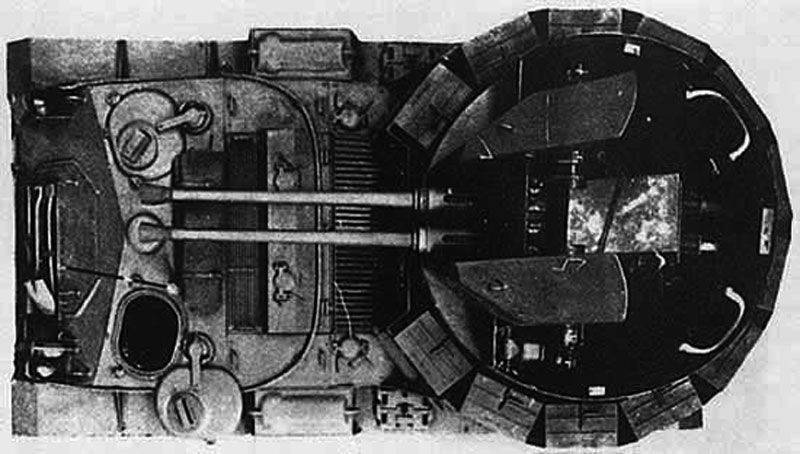
ZSU, view from above. Photo Militaryfactory.com
The first prototype ZSU T65E1 was built at the beginning of 1944, and soon went to the Aberdeen Proving Ground. In general, the car showed itself well, although it took some minor improvements. Checks and refinement experienced self-propelled continued until the summer. 14 June 1944, the new combat vehicle was put into service under the designation M19 Multiple Gun Motor Carriage. Soon the first contract for the serial construction of new equipment appeared.
In August, the United States Department of Defense 44 placed the first order for the construction of serial M19 in the number of 904 units. Cadillac and Massey-Harris should have built this technique. Their plants already had experience in the production of various armored vehicles, including M24 tanks, thanks to which they were able to quickly master the construction of self-propelled self-propelled guns. However, until the end of the war, only 285 (according to other data, 300) self-propelled guns were built, i.e. less than a third of the order. In view of the cessation of battles and the absence of the need for further mass production of such equipment, it was decided to abandon new supplies.
The first batches of the M19 MGMC were handed over to the customer until the end of 1944, thanks to which these machines were able to take part in the battles of World War II in Europe. Some sources mention that, due to the relatively late start of supply, the M19 cars could not fully begin to solve the initial problems. Battle aviation the anti-Hitler coalition inflicted serious damage on the Luftwaffe and won air superiority. Because of this, anti-aircraft self-propelled guns rarely had to defend their troops from attacks by enemy aircraft.
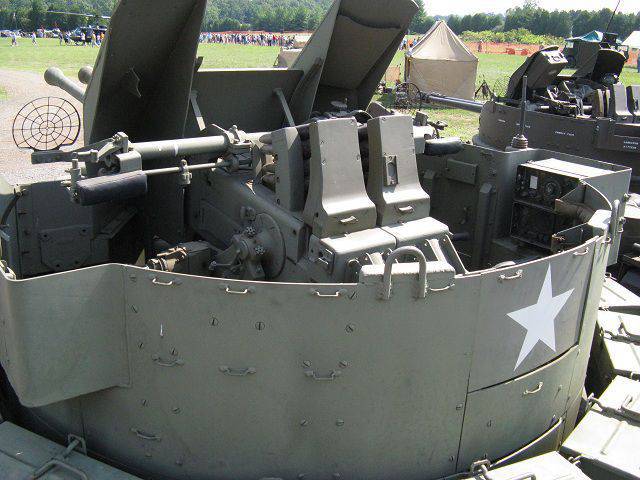
Tower with weapons of one of the museum cars. Photo Afvdb.50megs.com
However, M19 machines did participate in the battles, although not in the intended role. They were often used as an additional means of fire support for the ground forces. The characteristics of the Bofors guns made it possible with a certain efficiency to bombard buildings, fortifications, equipment and manpower of the enemy from long distances and thereby help the advancing units. As a result, until the end of the Second World War in Europe, the main task of anti-aircraft self-propelled guns was the attack of ground targets.
After the end of the war, the operation of the ZNU M19 continued. In addition, in the late forties, the available equipment of this type was upgraded by the project M19A1. The new project implied minor modifications to the gun installation, aimed at improving its performance and reliability, and also included the installation of an auxiliary power unit. In the upper part of the engine compartment, an additional low-power engine with a generator was mounted, with the help of which it was proposed to supply the existing equipment with the main engine turned off.
Already in the updated configuration M19A1 MGMC took part in the Korean War. According to reports, in this conflict, as during World War II, self-propelled guns often had to play the role of field artillery. By this time, the Chinese Air Forces already had a large number of modern jet aircraft, which were too difficult a target for cannon ZSUs. Low-speed North Korean aircraft, in turn, rarely appeared in the area of responsibility of the American anti-aircraft gunners.
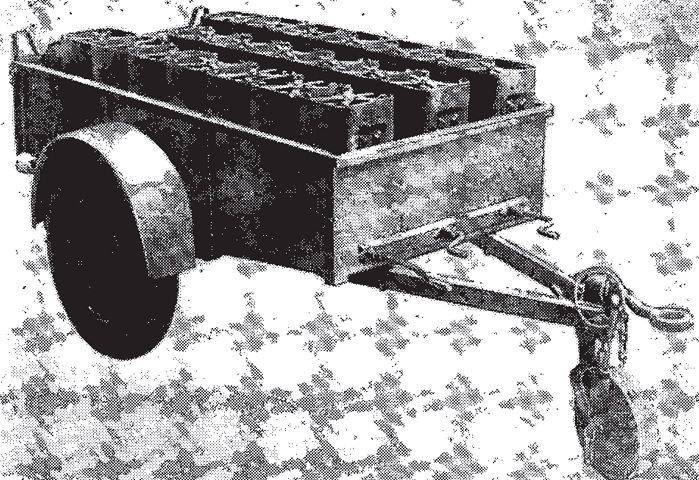
Trailer M28 with boxes M19. Photo Afvdb.50megs.com
At the same time, M19A1 again showed itself as a ground-based fire support. As such, they were used in the defense of the Pusan perimeter, in positional battles and subsequent offensive operations. As during World War II, a pair of 40-mm automatic guns allowed self-propelled guns to fight with light equipment and manpower of the enemy.
Service military vehicles M19A1 continued until the second half of the fifties. After that, all vehicles based on the M24 Chaffee tank began to be decommissioned and decommissioned. Self-propelled self-propelled guns were also disabled, but only partially utilized. The towers of these machines underwent repairs and upgrades with the installation of new systems, after which they were mounted on the chassis of the M41 Walker Bulldog light tanks. The resulting machines received the designation M42 Duster. The operation of such technology lasted until the eighties.
In total, nearly three hundred M19 MGMC machines were built, which took an active part in two wars. Some of this equipment was damaged or destroyed in the battles, some became the enemy's trophy, and some machines managed to survive in the battles and not get into recycling. Nearly two dozen M19 ZSUs, which are now museum pieces, have survived to this day. Among all the museum samples, three of them are of the greatest interest, namely, cars stored in the Russian Armored Museum in the town of Kubinka, in the Military Museum of Beijing and in the Pyongyang Museum of Victory in the Patriotic War of Liberation. These vehicles participated in the Korean War, during which they became trophies of the North Korean and Chinese troops. After that, one of the self-propelled guns was sent to the USSR for study, and then all three cars became museum exhibits. The rest of the preserved M19 are mostly kept in US museums.
On the materials of the sites:
http://historyofwar.org/
http://militaryfactory.com/
http://the.shadock.free.fr/
http://afvdb.50megs.com/
http://vn-parabellum.com/
The list of preserved M19 MGMC with photos:
http://the.shadock.free.fr/Surviving_M19_GMC.pdf
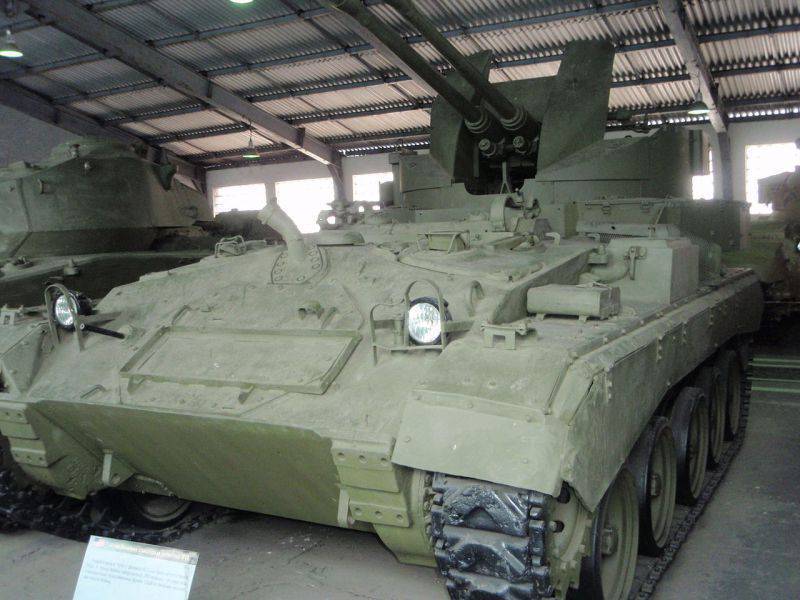
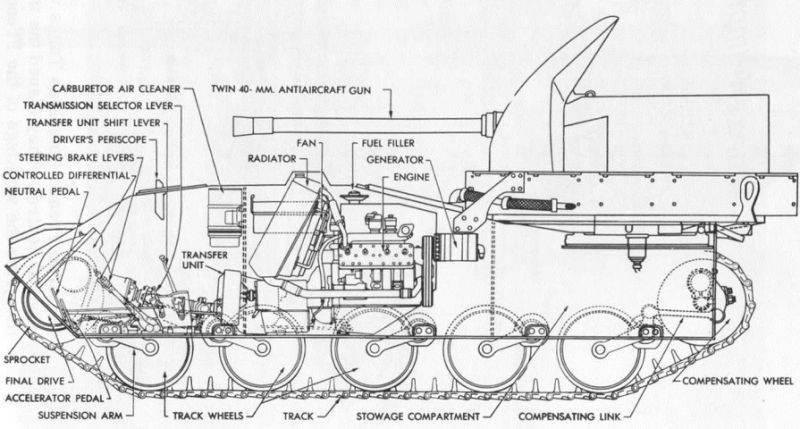
Information